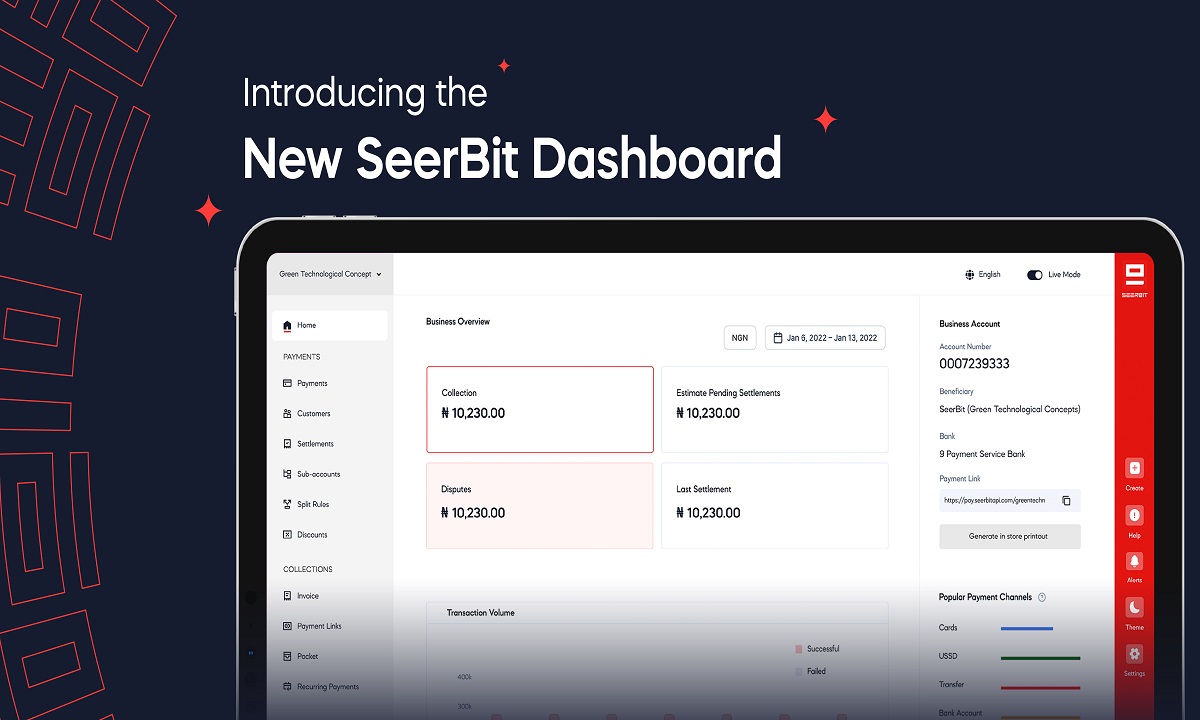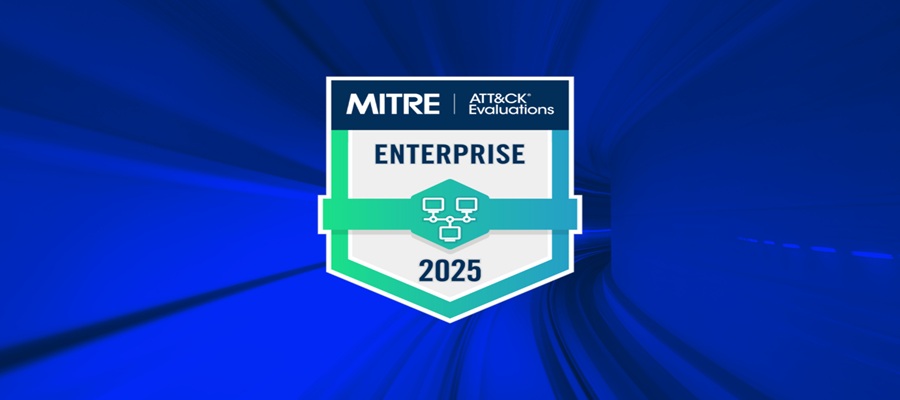Telecom
SeerBit New Merchant Dashboard: A Game-Changer for Business Efficiency

In today’s competitive marketplace, businesses need advanced tools to drive operational efficiency and fuel growth. SeerBit, a leading Pan-African payment company, is addressing these needs with the launch of its new, feature-rich merchant dashboard, set to go live on October 1, 2024.

Omoniyi Kolade, CEO of SeerBit
Designed for simplicity and ease of use, the revamped dashboard offers enhanced features, robust analytics, and an improved user interface, transforming how businesses manage transactions and streamline operations for growth.
‘‘We are excited to announce the launch of our latest innovation—the Merchant Portal Version 3.0, going live on October 1, 2024,’’ disclosed Babajide Shoyebo, Senior Product Manager at SeerBit.
‘‘The Merchant Portal Version 3.0 — accessible via https://dashboardv3.seerbit.com — is the latest evolution of our platform, specifically engineered to provide merchants with state-of-the-art tools and features that enhance operational efficiency, user engagement and overall business performance. This version represents our commitment to innovation and excellence, equipping merchants with everything they need to succeed in a competitive marketplace. Whether you’re a merchant in the e-commerce business, travel and hospitality, healthcare, digital services, financial services, or even in the education sector, this new portal is designed to meet the needs of users across diverse industries and help you achieve seamless business management.’’
Below is an overview of what to expect from the new SeerBit merchant dashboard, including some of the game-changing features and benefits for businesses.
A Modern, User-Friendly Interface
Ease of use is central to the redesign of the new merchant dashboard. Navigating through the portal is quicker, smoother and more intuitive than ever before. The platform is designed to ensure that everything is accessible with just a few clicks. This intuitive design ensures that both tech-savvy users and those less familiar with digital tools can maximise the portal’s full potential. Users can view all transactions, manage customer accounts and stay on top of settlements – without a steep learning curve. The improved layout makes it easier to access key features like transaction reports, customer management, settlement reports, refund processing, and invoicing, enabling merchants to focus on what truly matters—running their businesses.
Powerful New Features to Drive Your Business Forward
In addition to existing features, such as seamless onboarding, transaction reports, dispute reports, payment link and recurring payment, etc., this latest release introduces two highly anticipated features – Split Settlement and Invoicing. These tools are designed to simplify financial management, improve operational efficiency, and offer users greater flexibility in handling complex transactions.
a. Split Settlement: Flexibility for Complex Transactions
The split settlement feature allows you to divide a single payment between multiple accounts without having to manually calculate or handle the split, reducing the risk of errors and improving transparency. This is a game-changer for businesses that work with multiple stakeholders or sub-merchants. For example, marketplaces or businesses with commission structures can easily allocate incoming payments to different parties.
Imagine running an online marketplace where sellers, service providers, and platform fees all need to be handled within a single transaction. Split settlement simplifies this process, allowing you to decide how payments should be distributed across the board. This provides you with more control over your finances, while also saving valuable time that would otherwise be spent on manual reconciliation. The automated process ensures transparency and accuracy, giving merchants full visibility into how funds are distributed, helping businesses avoid bottlenecks and delays in processing.
b. Invoicing: Streamline Your Billing Process
Managing invoices can be a time-consuming task for businesses, particularly those handling multiple clients and transactions. The invoicing feature simplifies this process by enabling merchants to effortlessly create, send and track invoices directly from the dashboard. With just a few clicks, you can generate professional invoices with detailed breakdowns, including customer information and payment details, ready to be shared with your clients—ensuring timely and hassle-free payments.
Each invoice is embedded with a payment link, allowing customers to make payments instantly. This eliminates the need for manual payment collection or time-consuming follow-up communication. You’ll also receive real-time notifications as payments are made, keeping you informed without the need to chase clients or manually monitor your accounts. Your complete transaction history is stored on the platform, enabling you to track each invoice and effectively manage your finances.
For service-based businesses such as freelancers and consultants, invoicing has never been easier. The automation reduces administrative tasks, freeing up more time to focus on growing your business. It also improves cash flow by enabling faster payment turnaround and minimising the risk of payment delays.
Why This Matters: Empowering Businesses for Growth
Further expounding the benefits of the new rollout, Shoyebo said: ‘‘At SeerBit, we believe that merchants need more than just a platform for transactions—they need a comprehensive business management tool.
‘‘Merchant Portal Version 3.0 does just that by offering enhanced flexibility, control and visibility into your day-to-day operations. The introduction of invoice and split settlement represents our commitment to helping businesses streamline payment processes, reduce operational costs and improve customer satisfaction. These new features are not just about making transactions easier—they’re about empowering merchants to grow,” he stated.
The new SeerBit merchant dashboard is live from October 1, 2024 and is accessible at https://dashboardv3.seerbit.com.
Telecom
NITDA Charts Path for Kano as Innovation Hub

Mallam Kashifu Inuwa Abdullahi, Director-General of the National Information Technology Development Agency (NITDA), has called for a fundamental shift in Kano State’s economic strategy, urging stakeholders to embrace innovation, technology and collaboration as the drivers of growth in the 21st century.

Mallam Kashifu Inuwa Abdullahi, Director-General of the National Information Technology Development Agency (NITDA)
This is contained in a press statement e-authored by the Director of Corporate Communications & External Relations at NITDA, Hajia Hadiza Umar.
Speaking at the Kano Startup Weekend, Mallam Abdullahi acknowledged Kano’s long-standing reputation as the commercial nerve centre of Northern Nigeria and the wider Sahelian region, noting that its history of trade, enterprise and human capital provided a solid foundation for future growth.
Abdullahi emphasised that while these strengths powered Kano’s success for centuries, the modern economy now offered even greater opportunities through innovation and technology.
He described innovation as the process of transforming ideas into impactful solutions through commercialization, stressing that when ideas were effectively deployed, they created value, solved societal challenges and generated sustainable economic growth.
He noted that Kano’s large market, strategic location and vibrant entrepreneurial culture placed it in a strong position to take advantage of innovation-driven opportunities.
According to him, “Innovation is the process of taking an idea from inception to impact. Invention on its own is a cost centre, but when you commercialise an idea, when you turn it into a product or service that solves a real problem and creates value, that is when you begin to drive economic growth and inclusion.”
He noted that the state hosted numerous degree-awarding institutions across federal, state and private ownership, providing a strong base for human capital development.
However, the NITDA DG expressed concern that these institutions often operated in isolation from industry, with research outputs rarely translating into commercial or industrial applications.
He explained that innovation did not happen in silos and stressed the need for a strong, interconnected ecosystem that brought together academia, industry, startups, entrepreneurs and government.
According to him, universities should conduct research informed by industry needs, industries should leverage research to improve productivity and competitiveness, and startups should serve as the bridge that converted ideas into market-ready solutions.
The NITDA boss further encouraged entrepreneurs to leverage technology to build businesses that could grow beyond local markets, explaining that innovation-driven enterprises had the power to scale rapidly, create jobs and position Kano competitively at both national and global levels.
According to him, digital platforms and emerging technologies now made it easier for startups to reach wider markets and develop solutions that were previously unimaginable.
“You can start your business here in Kano, but your thinking must be global from day one. Technology has removed barriers. With the right skills and platforms, a startup in Kano can build solutions that serve not just Nigeria, but the world,” he noted.
Highlighting NITDA’s ongoing interventions, its Director-General outlined the Agency’s commitment to building national innovation capacity through targeted human capital development programmes.
He cited the Digital Literacy for All (DL4ALL) initiative, which aimed to equip Nigerians across all segments of society with essential digital skills, and the 3 Million Technical Talents (3MTT) programme, designed to produce a pipeline of globally competitive technical professionals in areas such as software development, data analysis and emerging technologies.
He said, “Through DL4ALL, we are ensuring that Nigerians at all levels have the basic digital skills needed to participate in the digital economy, while 3MTT is deliberately building a pipeline of globally competitive technical talents who can drive innovation, create jobs and attract investment.”
Abdullahi explained that these programmes were key pillars of President Bola Ahmed Tinubu’s Renewed Hope Agenda, which prioritised skills development, innovation, job creation and inclusive economic growth as pathways to national prosperity.
According to him, empowering Nigerians with digital and technical skills was essential for building a resilient economy capable of competing in the global digital landscape.
“President Tinubu’s Renewed Hope Agenda is about investing in people, empowering them with relevant skills and creating opportunities for inclusive growth.
“At NITDA, we are using digital skills and innovation as tools to translate that vision into real economic impact for Nigerians,” he said.
The NITDA boss urged all stakeholders in Kano to work together to build a functional innovation ecosystem that could unlock the state’s vast potential and expressed confidence that with the right mindset, strong collaboration and sustained investment in digital skills and innovation, Kano could reclaim its historic leadership role and emerge as a major innovation and entrepreneurship hub in Nigeria and beyond.
Telecom
Minister Claims Bandits Exploit Poor Network, Bounce Calls Off Multiple Towers

Bosun Tijani, minister of Communications, Innovation and Digital Economy, yesterday claimed that bandits and terrorists are able to communicate and coordinate their activities with ease because they exploit gaps in the country’s telecommunications network.

Bosun Tijani, minister of Communications, Innovation and Digital Economy,
Tijani, who spoke Politics Today, a Channels Television’s programme, on Friday, Tijani said the criminals exploit gaps in the country’s telecommunications network.
He also claimed the bandits use advanced technology to bounce calls across multiple towers in areas with poor connectivity.
“They weren’t using the normal towers; they bounced calls off multiple towers, which is why they favor areas that are largely unconnected,” he said.
When asked about reports that unregistered or fraudulently registered SIM cards are still in use despite the Bank Verification Number (BVN) and the National Identification Number (NIN)–Subscriber Identity Module linkage policies, Tijani said the issue is technically complex and the reports are not fully verified.
“Whether it’s fact or not, I do not know where you’re getting that from, and I do not know who has evidence that there are people with unregistered SIMs,” he added.
The minister stated that the federal government is investing in telecom towers in underserved regions, upgrading the country’s communication satellites to improve coverage, and expanding fiber-optic networks to strengthen the country’s digital infrastructure.
“If our towers are not working, our satellites will work. Nigeria is the only country in West Africa with communication satellites, and we are bringing new satellites to upgrade their capabilities,” Tijani said.
He added that these initiatives aim to ensure better connectivity for Nigerians while closing loopholes that criminals exploit, thereby enhancing national security.
The minister’s comments come amid rising concerns over insecurity in several parts of the North, where banditry, kidnapping, and terrorism have escalated in recent years.
There are also reports of bandits flaunting ransom payments on social media platforms such as TikTok, raising alarm among authorities and the public
Telecom
Sophos XDR Achieves its Best-Ever Results in the MITRE ATT&CK Enterprise 2025 Evaluation

Sophos, a global leader of innovative security solutions for defeating cyberattacks, has announced its best-ever results in the MITRE ATT&CK Enterprise 2025 Evaluation.

MITRE ATT&CK Enterprise 2025 Evaluation
Sophos XDR detected 100% of adversary behaviors (sub-steps)1 across two complex attack scenarios: Scattered Spider, which Sophos X-Ops tracks as GOLD HARVEST, a financially motivated cybercriminal collective, and Mustang Panda, which Sophos X-Ops tracks as BRONZE PRESIDENT, a People’s Republic of China (PRC) espionage group.
The Scattered Spider scenario included activity across Windows, Linux, and AWS cloud environments, and the Mustang Panda scenario focused on Windows only.
Further, Sophos achieved the highest-possible “Technique”-level rating for 86 out of 90 total sub-steps in the evaluation, by generating high-fidelity detections with details on execution, impact, and adversary behavior, providing clear who, what, when, where, how, and why insights.
Sophos XDR achieved:
- 100% detection coverage1 for all 90 adversary sub-steps across two complex attack scenarios across Windows, Linux, and AWS cloud environments
- Highest possible (“Technique”) ratings for 86 of 90 sub-steps, demonstrating deep visibility and actionable detections
- Highest possible (“Technique”) ratings for 61 out of 62 of sub-steps in the Scattered Spider scenario involving identity abuse, cloud exploitation, and data exfiltration
“Scattered Spider and Mustang Panda represent distinct threat profiles that challenge defenders in very different ways,” said Simon Reed, chief research and scientific officer, Sophos. “Achieving full detection coverage against both validates the accuracy and depth of Sophos’ analytics and demonstrates how the company’s AI-native XDR platform converts complex telemetry into clear, actionable intelligence, helping security teams detect, understand, and stop advanced attacks with confidence.
“Sophos’ consistently strong performance in these rigorous evaluations underscores the power and precision of our threat detection and response capabilities, and our commitment to stopping the world’s most sophisticated cyberthreats.
“Over the five years that Sophos has participated in ATT&CK Evaluations, we have continually invested in strengthening our platform, and that investment has translated into stronger results year after year – both in the evaluations, and in the security outcomes we deliver for our customers.”
These results demonstrate the power of the Sophos XDR platform to defend against sophisticated cyber threats. Every day, Sophos processes 223+ terabytes of telemetry in Sophos Central, generating 34+ million detections and automatically blocking 11+ million threats.
This scale of customer insights ensures that Sophos’ detections are being tested and improved to provide continuous protection while delivering stronger outcomes for organizations worldwide.
Understanding The Threat Actors
Sophos X-Ops has tracked GOLD HARVEST (Scattered Spider) since 2022, observing a loosely affiliated cybercriminal collective driven by both financial motives and a desire to elevate their reputations on underground forums.
Despite several arrests, operators and associates continue to launch high-profile attacks across the U.K. and U.S., at times partnering with major Russian-speaking ransomware groups.
Their sophisticated social engineering capabilities enable them to compromise even well-defended organizations, underscoring the importance of strong behavioral detections within modern security operations.
In parallel, Sophos X-Ops has monitored BRONZE PRESIDENT (Mustang Panda) for many years.
This long-running PRC espionage group conducts intelligence-led operations that align closely with priorities of China’s Ministry of State Security. Recent targeting includes activity against Tibetan communities surrounding the Dalai Lama’s 90th birthday, as well as intrusions on Thai government and military offices during periods of heightened regional tension.
BRONZE PRESIDENT remains one of the most active and persistent state-aligned threat actors operating today.
MITRE ATT&CK Evaluations are among the world’s most rigorous independent security tests.
They emulate the tactics, techniques, and procedures (TTPs) used by real-world adversaries to assess each participating vendor’s ability to detect, analyze, and articulate threats in alignment with the MITRE ATT&CK Framework.
These evaluations continually strengthen Sophos’ capabilities for the benefit of the organizations it protects. This was the seventh round of MITRE’s “Enterprise” ATT&CK Evaluation, a product-focused assessment designed to help organizations better understand how security operations solutions like Sophos EDR and Sophos XDR can help them defend against sophisticated, multi-stage attacks.
When evaluating EDR or XDR solutions, Sophos recommends reviewing MITRE ATT&CK Evaluations alongside other independent proof points.

 Telecom2 days ago
Telecom2 days agoMinister Claims Bandits Exploit Poor Network, Bounce Calls Off Multiple Towers

 E-Financial2 days ago
E-Financial2 days agoFIRS says MOU with DGFIP Won’t Compromise Nigeria Tax Data Sovereignty

 General News2 days ago
General News2 days agoTop Nigerian Startups Secure Funding Boost @ iHatch Demo Day Awards

 Telecom2 days ago
Telecom2 days agoCBN, NCC to Launch Short Code for Swift Consumer Complaint Resolution

 Telecom2 days ago
Telecom2 days agoGoogle.org Backs CyberSafe’s Resilio Africa to Shield 2m People from Cyber Threats

 Broadcasting2 days ago
Broadcasting2 days agoNCC Blocks Piracy Sites as Nollywood Faces Rising Digital Theft

 Broadcasting2 days ago
Broadcasting2 days agoFour Must-Watch African Films Debut Free on Glo TV

 Telecom2 days ago
Telecom2 days agoNASENI Launches FutureMakers to Inspire Innovation in Young Nigerians


























